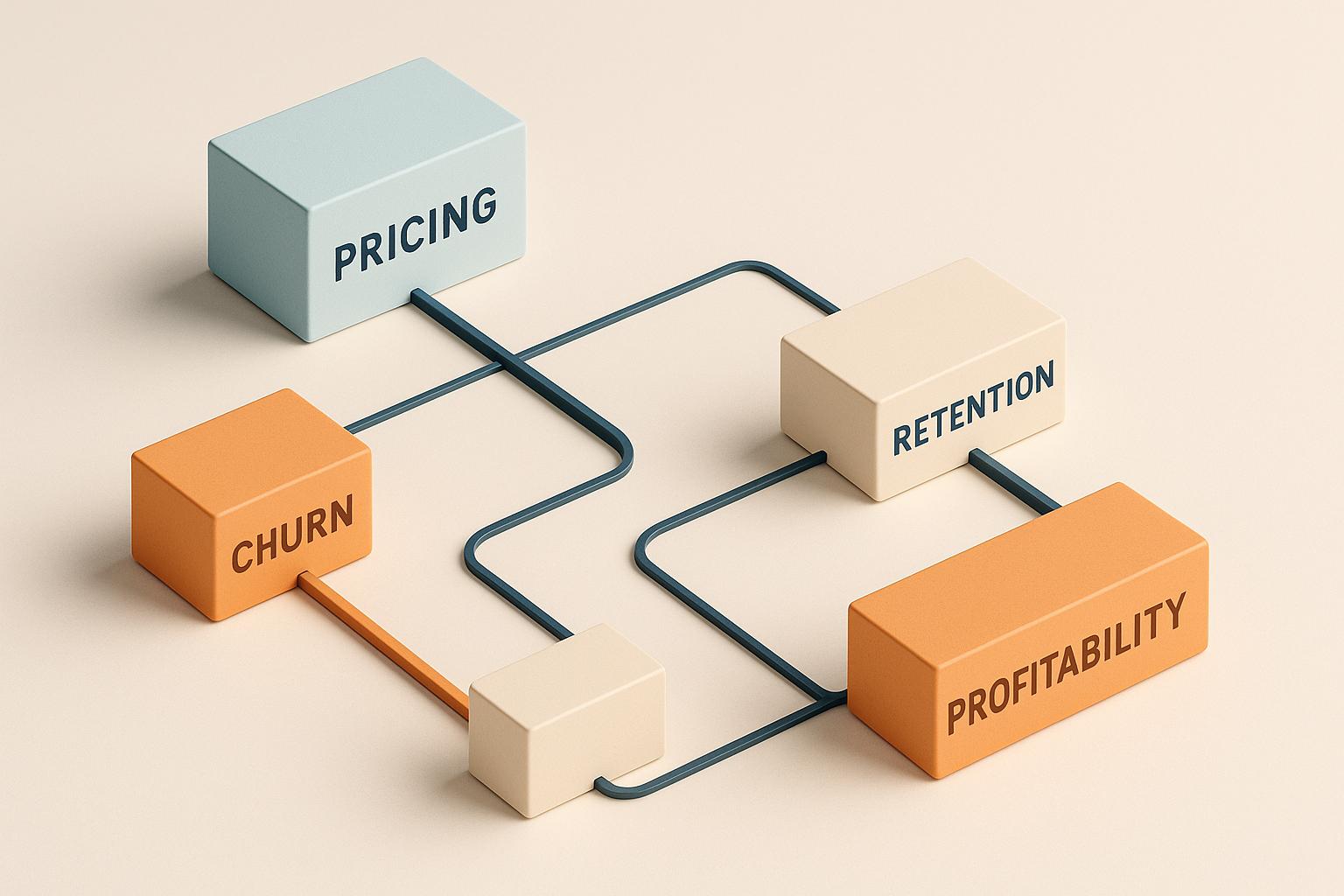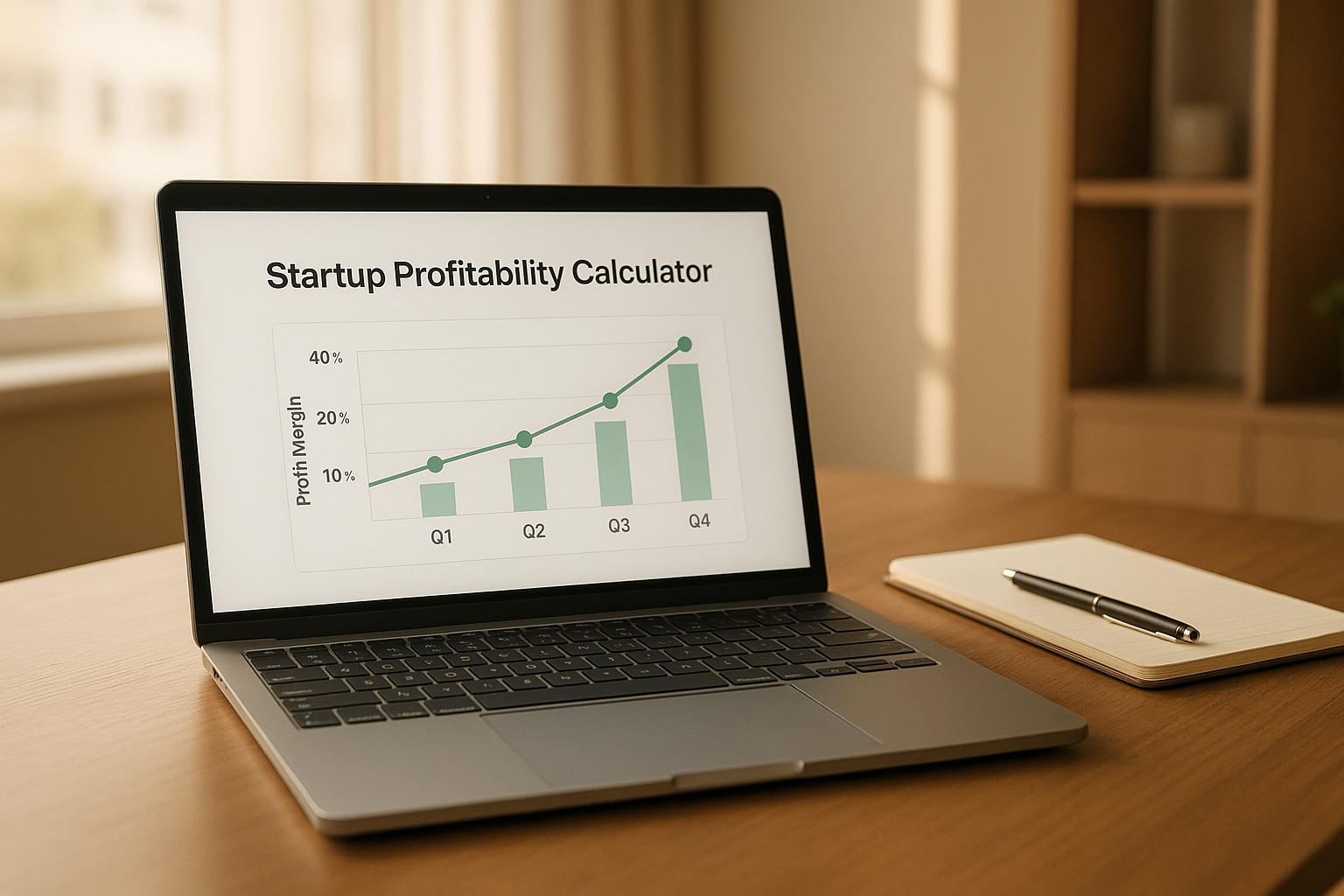Checklist for Implementing AI in Financial Forecasting

AI can make financial forecasting faster, more accurate, and scalable. Here’s a quick-start checklist:
- Review Your Current Process: Identify inefficiencies like manual data entry or limited pattern detection.
- Set Goals: Focus on improving accuracy, saving time, and handling larger datasets.
- Prepare Your Data: Clean and organize financial data, ensure security, and choose scalable storage solutions.
- Choose AI Tools: Look for tools with advanced forecasting models, real-time analysis, and industry-specific features.
- Build and Test Models: Train models with historical data, validate performance, and refine predictions regularly.
- Integrate AI: Connect AI tools to existing systems, define performance metrics, and monitor results.
- Train Teams: Teach employees to use AI tools effectively and involve stakeholders in the process.
- Get Expert Help: Work with advisors for data engineering, system integration, and strategy alignment.
Quick Comparison: Traditional vs. AI-Enhanced Forecasting
| Feature | Traditional Forecasting | AI-Enhanced Forecasting |
|---|---|---|
| Data Processing | Manual | Automated, real-time |
| Accuracy | Limited | Advanced pattern recognition |
| Scalability | Time-consuming updates | Handles large datasets |
| Time Management | Slow reporting cycles | Instant insights |
AI transforms financial forecasting by automating repetitive tasks and improving decision-making. Start by assessing your current process and preparing your data for AI integration.
1. Review Your Current Financial Forecasting Process
Taking a close look at your current process can help you spot areas where AI can bring the most value and make the shift to advanced methods smoother.
Pinpoint Challenges in Forecasting
Start by identifying the obstacles in your current forecasting setup.
| Challenge Area | Issues | AI Solution |
|---|---|---|
| Data Processing | Errors from manual entry | Automated data collection |
| Accuracy | Limited pattern detection | Advanced algorithmic analysis |
| Scalability | Time-consuming updates | Real-time processing |
| Time Management | Slow reporting cycles | Instant insights |
For example, Siemens faced similar issues before adopting AI. By carefully examining their processes, they pinpointed key areas for improvement. This led to a 10% increase in prediction accuracy after implementing AI. Identifying your challenges early ensures AI can tackle inefficiencies effectively.
Set Goals for AI Integration
Establish clear, measurable objectives that align with your business needs. This will help you track progress and prove the value of AI.
Focus on these priorities when setting goals:
- Accuracy Targets: Define specific improvements in forecast accuracy, such as a percentage increase.
- Time Savings: Set goals to reduce manual tasks and streamline workflows.
- Scalability: Plan for the number of additional data points your system should handle.
Key performance indicators (KPIs) to consider include:
- Forecast accuracy percentages
- Time spent on manual data tasks
- Precision in cash flow predictions
- Risk assessment reliability
- Real-time reporting efficiency
Once your goals are clear, you're ready to prepare your data for AI integration.
2. Prepare Your Data for AI
Clean and Organize Financial Data
Start by ensuring your financial data is accurate, complete, and consistent. Standardizing data formats and creating clear data dictionaries can help maintain uniformity across datasets.
Pay attention to accuracy by removing duplicate entries, filling gaps in historical data, and keeping formats consistent. Regular updates are also critical. These steps can reduce prediction errors by up to 30% and make model training more reliable. Simply put, the better your data quality, the more precise your forecasts will be.
Establish Data Security Policies
Protect sensitive financial data with strong security measures. A solid framework should include:
- Data encryption for both storage and transmission
- Access controls to limit who can view or modify data
- Regular audits to identify and address vulnerabilities
- Compliance checks to meet regulatory standards
Once your data is secure, focus on choosing a storage solution that supports your AI needs effectively.
Choose Reliable Data Storage
Opt for storage solutions that are secure, scalable, and compatible with AI systems. Cloud-based platforms are a great choice for financial forecasting, offering flexibility and strong security.
Cloud platforms stand out because they:
- Handle large-scale AI model training
- Ensure compliance with security standards
- Enable real-time data processing
- Integrate smoothly with existing systems
3. Select the Right AI Tools
Once your data is prepared, the next step is choosing AI tools that match your financial forecasting objectives.
Compare AI Platforms and Their Features
When evaluating AI tools for financial forecasting, focus on their ability to handle large data volumes, integrate smoothly with your existing systems, and the level of vendor support they provide.
Here’s a breakdown of key features to consider:
| Feature Category | What to Look For |
|---|---|
| Data Processing | Automated preprocessing and support for multiple data sources |
| Model Capabilities | Advanced forecasting models like ARIMA or SARIMA |
| Integration | API accessibility and compatibility with current software |
| Support & Updates | Availability of training materials and technical support |
After identifying platforms with these capabilities, refine your options by focusing on tools designed specifically for financial forecasting.
Consider Tools Built for Your Industry
Using tools designed specifically for financial forecasting can improve accuracy and ensure regulatory requirements are met. These specialized platforms often include features that general-purpose AI tools don’t offer.
For instance, tools like Planful Predict and Predict: Signals provide features such as:
- Advanced anomaly detection for financial data
- Detailed scenario planning
- Accurate boundary predictions
- Monitoring for regulatory compliance
If you're unsure which tool is the right fit, Phoenix Strategy Group can assist in evaluating options to find a solution that meets your current needs while preparing for future growth.
4. Build and Test AI Models
Once you've chosen the right AI tools, the next step is creating and testing your financial forecasting models. This stage focuses heavily on ensuring data quality and validating the model's performance.
Train Models with Historical Data
Start by training your AI models using clean, standardized historical data from the past 3-5 years. This should include financial statements, market metrics, and economic indicators. Each type of data plays a specific role in forecasting - financial statements help with revenue predictions, market metrics identify trends, and economic indicators support long-term planning. For instance, revenue tracking becomes more precise with accurate financial data, while broader economic data helps anticipate future challenges.
Validate and Refine Model Performance
Testing your model's predictions against historical outcomes is key to ensuring reliable forecasts. Use metrics like Mean Absolute Error (MAE) or Mean Squared Error (MSE) to measure accuracy. Over time, AI models adjust to market shifts and economic changes, improving their predictions.
To keep the models performing well, monitor their accuracy regularly, fine-tune parameters (like learning rates or algorithm settings), and update training data with the latest financial information. For more complex setups, consulting financial advisory experts can be a smart move. Firms like Phoenix Strategy Group specialize in fine-tuning AI forecasting models to stay aligned with market changes while maintaining accuracy.
After validating and optimizing your models, the next step is integrating them into your financial processes for real-time forecasting. Strong, accurate AI models can transform financial planning, offering businesses the tools they need for data-driven decision-making and growth.
sbb-itb-e766981
5. Integrate AI into Financial Processes
Connect AI to Existing Systems
To make AI work effectively in your financial processes, it's essential to link AI tools with your current systems. Start by pinpointing how AI forecasting models can interact with your core platforms, like ERP systems or accounting software. Many AI platforms have APIs that allow for smooth data exchange between systems.
A good strategy is to begin with one system - your general ledger, for instance - before moving on to others. This step-by-step approach helps you troubleshoot any issues early on without causing major disruptions. After integration, focus on tracking performance to ensure the AI tools are delivering the results you need.
Set Performance Metrics
Defining clear KPIs is key to measuring how well your AI forecasting system is performing. Choose metrics that tie directly to your business goals and provide actionable feedback.
| Metric Type | Description |
|---|---|
| Accuracy Metrics | Measure performance using indicators like MAE (Mean Absolute Error) or MSE (Mean Squared Error). |
| Time-based Metrics | Assess how quickly forecasts are completed and how often updates are made. |
| Business Impact | Evaluate outcomes such as cost savings and better resource utilization. |
By tracking these metrics consistently, you can ensure your AI systems stay on track with your objectives, justify your investment, and spot areas for improvement.
Monitor and Update AI Models
Keeping your AI models accurate requires regular updates and reviews. Set up a structured process to monitor performance and catch potential issues before they affect your forecasts.
Watch for shifts in data patterns, refresh training data monthly, and recalibrate your models every quarter. If problems arise, consult AI specialists or adjust system settings promptly to maintain reliability and accuracy. Frequent checks and updates ensure your AI tools continue to deliver value over time.
6. Train Teams and Manage Change
Offer AI Training for Employees
Begin with the basics - covering topics like data preparation and understanding AI models. Then, move on to practical exercises that teach employees how to use your chosen AI tools effectively.
Here’s a simple way to structure your training program:
| Training Component | Focus Areas | Expected Outcomes |
|---|---|---|
| AI Fundamentals | Core concepts, data analysis basics | Clear understanding of AI's strengths and limitations |
| Technical Skills | Preparing data, selecting models | Confidence in handling data and ensuring accuracy |
| Practical Application | Case studies, forecasting examples | Ability to apply AI tools in day-to-day tasks |
| Advanced Topics | Interpreting models, integrating systems | Expertise in leveraging AI insights for decisions |
Workshops that use your company's data are a great way to give employees hands-on experience. This method not only teaches skills but also boosts confidence in applying what they've learned.
Once your team is trained, the next step is to ensure stakeholders are on board.
Explain AI Benefits to Stakeholders
Clearly outline how AI can improve decision-making to gain support and address potential concerns. Highlight that AI is a tool to enhance human capabilities, not replace them.
Share real-world case studies where AI has been successfully implemented. For example, companies have used advanced AI models paired with dashboards to provide actionable insights, enabling managers to make smarter decisions.
Set up governance frameworks to ensure trust in AI usage. This includes defining limits for AI decision-making and keeping human oversight for critical choices, especially in financial matters. Regular updates on project progress and performance metrics also help maintain transparency and show the value AI brings.
If your organization needs extra guidance, working with experienced advisors can be a smart move. They can help tailor training programs, manage the technical rollout, and support your team as they adjust to new processes and workflows.
7. Get Expert Help for AI Implementation
How Advisors Can Support AI Adoption
Advisory firms play a key role in handling the complexities of AI integration while ensuring it aligns with your business goals.
Here’s how expert advisors can assist:
| Support Area | Key Advantages | What They Provide |
|---|---|---|
| Data Engineering | High-quality, structured data | AI-ready, clean financial data |
| Technical Implementation | Smooth integration with current systems | Custom AI models and workflows |
| Strategic Planning | Clear alignment with business goals | A detailed roadmap for implementation |
| Risk Management | Strong compliance and security | Governance frameworks and protocols |
Custom Solutions for Growing Businesses
For companies experiencing rapid growth, tailored advisory solutions can address specific challenges while keeping pace with expansion. Firms like Phoenix Strategy Group specialize in crafting personalized strategies that evolve with your business.
These services often include:
- Setting up secure, scalable data infrastructure
- Creating AI models designed for your industry
- Integrating AI tools seamlessly into existing workflows
When selecting advisors, look for those with deep industry knowledge, a proven track record in AI projects, robust security measures, and scalable solutions. With the right guidance, your business can implement AI tools effectively and set the stage for long-term success.
Steps to Use AI in Financial Forecasting
Key Phases and Actions
To integrate AI into financial forecasting, start by assessing your current processes and defining clear objectives. The first step is preparing your data - cleaning, organizing, and securely storing it to ensure it's ready for AI tools.
Next, focus on selecting the right tools and platforms tailored to your industry. Solutions like Planful Predict showcase how machine learning can analyze complex patterns and deliver precise predictions.
| Phase | Actions | Outcomes |
|---|---|---|
| Foundation | Data cleaning, Security setup | AI-ready financial dataset |
| Technology | Tool selection, Model building | Customized AI forecasting system |
| Integration | System connection, Team training | Streamlined workflow |
| Optimization | Performance tracking, Model updates | Improved forecasting accuracy |
Each phase builds on the last, creating a solid framework for implementing AI in your financial processes.
Why AI Matters for Financial Forecasting
AI isn't just a tool - it changes how financial teams work. By automating repetitive tasks and offering real-time insights, AI frees up teams to focus on strategic decisions. Its ability to adjust to changing data ensures forecasts stay accurate, even as conditions shift.
For businesses looking to grow, AI makes forecasting more precise and efficient. It supports better scenario planning and resource allocation, helping companies scale operations effectively.
FAQs
How to use AI for financial forecasting?
Using AI for financial forecasting involves integrating data and technology effectively. Here's a breakdown of what finance teams should focus on:
| Key Component | Implementation Details | Expected Outcome |
|---|---|---|
| Data Preparation | Organize and clean data to make it AI-ready | A dependable dataset for analysis |
| Model Selection | Pick time series models (e.g., ARIMA, SARIMA) or machine learning models (e.g., random forests) | A tailored forecasting approach |
| Automation Level | Use tools to automate data collection and analysis | Less reliance on manual processes |
| Monitoring System | Continuously track performance and recalibrate models | Consistent accuracy over time |
For instance, Siemens saw a 10% improvement in prediction accuracy after applying AI-driven financial models.
Advisory firms like Phoenix Strategy Group specialize in areas like data engineering, FP&A, and AI integration, helping businesses align technology with their objectives.
The success of AI in financial forecasting hinges on clean data, reliable models, skilled teams, and ongoing monitoring. While AI tools enhance decision-making, they work best alongside human expertise.
Training finance teams is crucial so they can properly use AI tools and interpret the results. Regular model validation is essential to ensure forecasts remain accurate.




